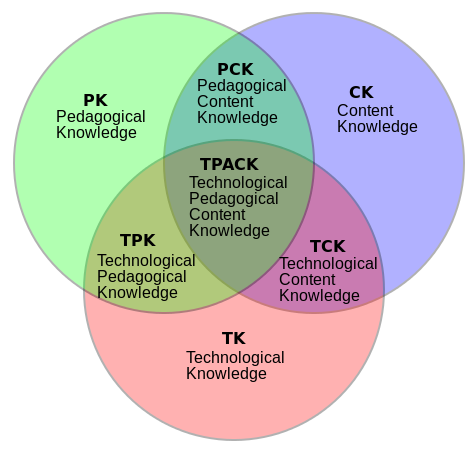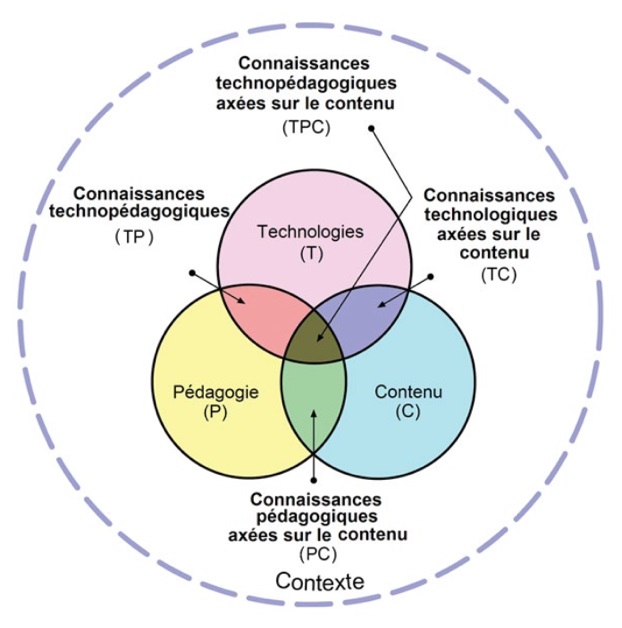TPACK
Aller à la navigation
Aller à la recherche
| Bases psychopédagogiques des technologies éducatives | |
|---|---|
| Module: Intégration de pédagogies numériques | |
| ▲ | |
| ⚐ | ☸ |
| ⚒ 2020/05/31 | |
| Sous-pages et productions: | |
Introduction
Le modèle "TPACK" dévelopé par Koehler et al. présente une manière d'aborder l'intégration de la technologie dans l'éducation.
Lire
Mishra et Koehler, 2006[1]
Lire aussi
Mishra et Koehler, 2009[2]


Liens
- tpack.org, Homepage of the initiative (started in nov 2012 by Koehler et al.), includes training materials, bibliography, etc.
- TPACK – Technological Pedagogical and Content Knowledge by Matthew J. Koehler (also linked through http://www.tpack.org). This website includes tools for practitioners and researchers (e.g. survey instruments), etc.
- Mendely TPACK group
- TPACK (was TPCK) by Puny Mishra.
- Technological Pedagogical Content Knowledge (Wikipedia)
Bibliographie
Textes cités
- ↑ Mishra, P., & Koehler, M. J. (2006). Technological Pedagogical Content Knowledge: A new framework for teacher knowledge. Teachers College Record. 108(6), 1017-1054. PDF Reprint
- ↑ Koehler, M., & Mishra, P. (2009). What is Technological Pedagogical Content Knowledge? . Contemporary Issues in Technology and Teacher Education, 9(1). PDF Reprint
Autres
- AACTE (Ed.). (2008). Handbook of technological pedagogical content knowledge (TPCK) for educators. New York: Routledge. DOI: 10.21432/T2CS3G
- Archambault, L., & Crippen, K. (2009). Examining TPACK among K-12 online distance educators in the United States Contemporary Issues in Technology and Teacher Education, 9(1). Retrieved from http://www.citejournal.org/vol9/iss1/general/article2.cfm
- Barbour, Michael; Lloyd P. Rieber, Gretchen Thomas, and Dawn Rauscher (2009). Homemade PowerPoint Games: A Constructionist Alternative to WebQuests, TechTrends 53 (5), 54-59. DOI:10.1007/s11528-009-0326-2
- Bos, B. (2011). Professional development for elementary teachers using TPACK. Contemporary Issues in Technology and Teacher Education, 11(2). Retrieved from http://www.citejournal.org/vol11/iss2/mathematics/article1.cfm
- Graham, Charles R.; Nicolette Burgoyne, Pamela Cantrell, Leigh Smith, Larry St. Clair, and Ron Harris (2009). TPACK Development in Science Teaching: Measuring the TPACK Confidence of Inservice Science Teachers. Techtrends, 53 (5), 70-79. DOI:10.1007/s11528-009-0328-0
- Hammond, T. C., & Manfra, M. M. (2009). Giving, prompting, making: Aligning technology and pedagogy within TPACK for social studies instruction. Contemporary Issues in Technology and Teacher Education [Online serial], 9(2). Retrieved from http://www.citejournal.org/vol9/iss2/socialstudies/article1.cfm
- Hofer, M., & Swan, K. O. (2006). Technological Pedagogical Content Knowledge in Action : A Case Study of a Middle School Digital Documentary Project. Journal of Research on Technology in Education, 41(2), 179-200. http://www.iste.org/
- Koehler, M., & Mishra, P. (2009). What is Technological Pedagogical Content Knowledge? . Contemporary Issues in Technology and Teacher Education, 9(1). https://www.researchgate.net/publication/241616400_What_Is_Technological_Pedagogical_Content_Knowledge
- Koehler, M. J., & Mishra, P. (2008). Introducing TPCK. In AACTE Committee on Innovation and Technology (Ed.), Handbook of technological pedagogical content knowledge (TPCK) for educators (pp. 3-29). New York: Routledge.(PDF.)
- Koehler, M. J., & Mishra, P. (2005). What happens when teachers design educational technology? The development of Technological Pedagogical Content Knowledge. Journal of Educational Computing Research, 32(2), 131-152. https://doi.org/10.2190/0EW7-01WB-BKHL-QDYV
- Lim, C. P. (2009). Formulating guidelines for instructional planning in technology enhanced learning environments. Journal Of Interactive Learning Research, 20(1), 55-74. AACE. Retrieved from http://www.editlib.org/p/24462
- Mishra, P., & Koehler, M. J. (2006). Technological pedagogical content knowledge: A framework for teacher knowledge. Teachers College Record, 108(6), 1017-1054. http://dx.doi.org/10.1111/j.1467-9620.2006.00684.x
- Nkwenti Ndongfack, M. (2015). Mastery of Active and Shared Learning Processes for Techno-Pedagogy (MASLEPT): A Model for Teacher Professional Development on Technology Integration. Creative Education, 6, 32-45. http://dx.doi.org/10.4236/ce.2015.61003
- Niess, M. L., Ronau, R. N., Shafer, K. G., Driskell, S. O., Harper, S. R., & Johnston, C. (2009). Mathematics Teacher TPACK Standards and Development Model. Contemporary Issues in Technology and Teacher Education, 9, 4-24. (PDF.)
- Polly, Drew & Laurie Brantley-Dias (2009). TPACK: Where do we go now?,Techtrends, 53 (5), 46-47. DOI:10.1007/s11528-009-0324-4
- Polly, D., & Mims, C. (in press). Supporting the integration of Web 2.0 technologies in professional development programs. In T. Kidd & I. Chen (Eds.), Wired for learning: An educators guide to Web 2.0. Hershey, PA: Information Science Reference.
- Shulman, L. S. (1986). Those who understand: Knowledge growth in teaching. Educational Researcher, 15(2), 4-14. (This is the original) (PDF.)
Créer une nouvelle sous-page production vidéographie
Ajouter une nouvelle production (MAX par promotion = 2)
Sous-pages qui existent déjà et (y compris des productions):